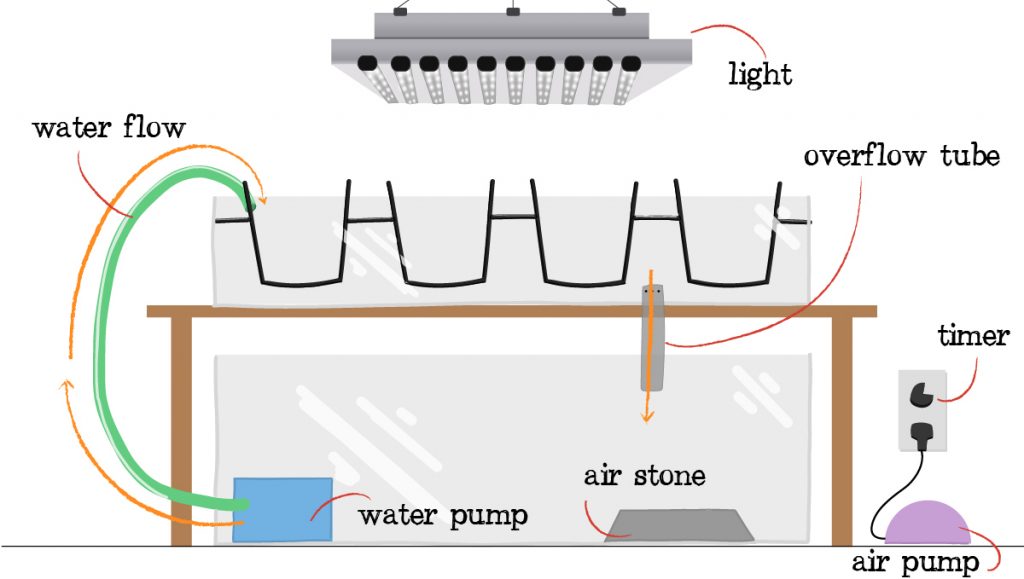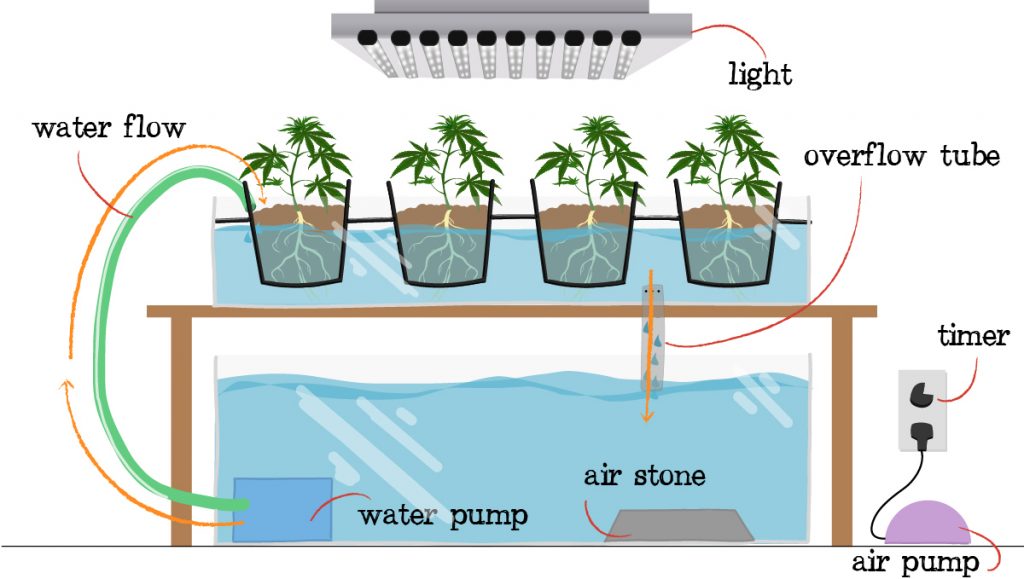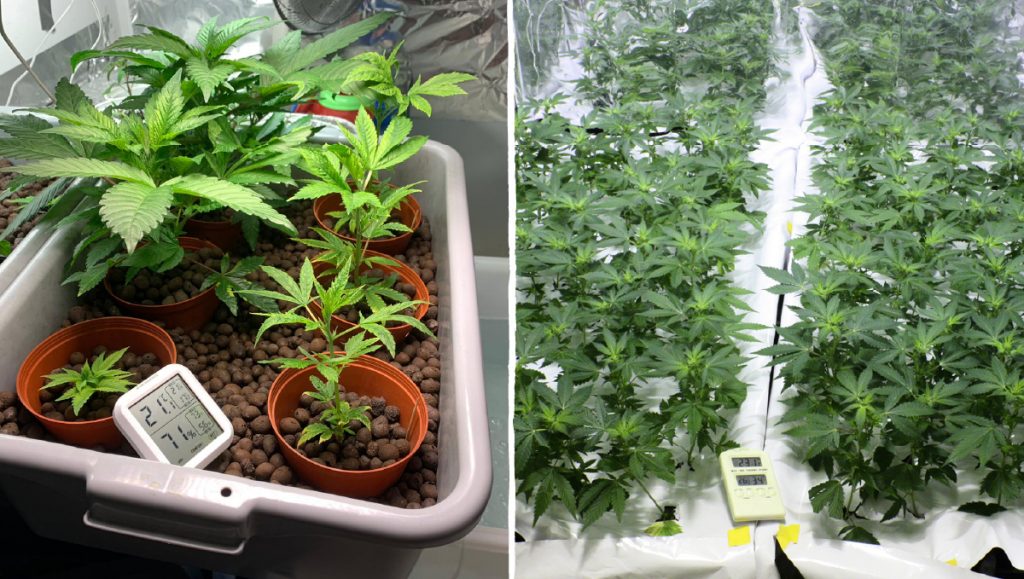Ebb and Flow Hydroponic Setup
UncategorizedEbb and flow cannabis growing is a simple and effective method of growing cannabis. This type of system is very popular because it can be done easily and cheaply but just like any other hydro system, needs monitoring to ensure it’s running correctly. So read along for everything you need to know about one of the simplest hydroponic grow methods available!
1. What Is Ebb and Flow?
An ebb and flow system (aka flood and drain) is a hydroponic grow system where oxygenated water with nutrients (basically the nutrient solution) flows over plants in an inert medium. In order to do this, an ebb and flw system uses a single water pump to flood the tray where the plants are growing in, and after the plants are fed, gravity forces the water to go back to the reservoir.

Just like all hydroponic setups, the nutrient solution provides all the nutrients the plants need and the inert medium is used for the roots to anchor to and provide more stability. An important aspect of this type of hydroponic system is that the medium should not contain any nutrients so it’s not recommended to use organic substrates such as soil, for example.
Ebb and flow systems have been used to grow vegetables for a long time and have recently started being used with cannabis due to how clean and convenient it is for indoor growers, resulting in high yields without much maintenance.
1.1 Pros and Cons of Ebb and Flow Hydroponics
Due to the roots being directly in the nutrient solution, you need to keep it at the right temperature, but apart from maintaining the nutrient solution on check, there are pros and cons specific to this type of system, they’re:
Pros of Ebb and flow
- After the initial setup, this type of system is 100% automated so it’s super easy to maintain.
- There’s no need to maintain the nutrient solution and the right temperature due to the limited exposure to the nutrient solution.
- It’s probably the best option for those who want to grow hydroponically without spending too much or needing a lot of space.
Cons of Ebb and flow
- Needs constant monitoring because it depends on only one pump, so an equipment failure can end up killing your whole crop.
- Due to all the roots being exposed to the same nutrient solution at the same time, diseases can spread easily so you need to keep everything extremely clean.
- It’s essential to ensure good drainage because stagnant water can cause root rot.
2. How Do Ebb and Flow Cannabis Setups Work?
As mentioned, this type of hydroponic system works by flooding the plants’ roots 1 to 12 or more times per day. This allows plants to absorb what they need during flooding and after the nutrient solution drains, the roots also get oxygen, which is essential for root growth. There are different ways to set up an ebb and flow system, but in general, this type of system requires a tray were filled with an inert medium such as clay pellets or perlite, or pots with these mediums and then placed on the tray. In all types of ebb and flow setups, you need the tray because you have to flood the plants with the nutrient solution.

In order to flood and then drain the tray, you need a timer that turns the water pump on periodically, filling the tray with the nutrient solution. Once the timer turns the water pump off, the nutrient solution can then drain back to the reservoir, and an overflow outlet prevents the tray from overflowing and flooding your whole grow room with the nutrient solution. So basically, you only need four things to make your own ebb and flow setup:
- Plant tray;
- Water reservoir;
- Water pump and;
- A timer.
3. Ebb and Flow System for Weed
There are a lot of excellent ebb and flow setups available in grow shops, these pre-built systems offer effective and easy-to-use equipment starting at $200-$250 but which is relatively cheap but you can make your own for less than half and adapt it to your grow space and your needs.
Building your own ebb and flow system is super easy and you don’t need a lot to make it work just like a store-bought one, so if you’re looking to make your own hydro ebb and flow setup, here’s what you’ll need:
- Bucket or plastic box with a lid to serve as the water reservoir;
- Plant tray;
- Water pump;
- Two fill and drain fittings;
- Black tubing to flood the tray and;
- Another piece of black tubing to regulate overflow.
Once you gather everything, the idea is to build the system so that the water pump can fill the tray and then drain it off, with the overflow regulators to prevent overflowing. So if you’re ready to start building, here’s what you need to do.
Step 1
Make 2 holes in the center of the plant tray, place the plant tray on top of the reservoir and make corresponding holes in the lid. Align the holes and join them together with the fill and drain fittings.
Step 2
Grab the black tubing and attach one end to the water pump and the other end to one of the holes in the tray/lid. Then grab the other tubing (that will serve as the overflow regulator) and attach it to the other fill and drain fitting.
Step 3
Next, fill the reservoir with water and place the water pump in the water reservoir, set your timer accordingly, and test the system.
Step 4
If there aren’t any water leaks and the tray flood and drains correctly, you can add the nutrient solution to the reservoir, place your plant on the tray and start growing!
If you don’t understand exactly how to know if the system is working, keep in mind that the timer should turn ON at the right time, which should turn the water pump ON, flooding the tray with the nutrient solution without overflowing. It’s essential you make sure the overflow tubing is working correctly before starting your grow cycle. Once the timer turns OFF, the nutrient solution should drain back to the reservoir.
This guide uses the flood tubing as a drain tubing too, but you can make an extra hole to have separate flood and drain tubings, just remember that depending on the medium used, you should have a mesh or filter at the bottom of the tray to prevent the medium from blocking the tubes.
4. Ebb and Flow Cannabis Grow Guide
Now that you know how to build an ebb and flow cannabis system and how it works, let’s learn a bit more about the different media you can use and how to feed cannabis plants in this type of system.
There are a lot of different growing media for this type of system. If you’re growing in individual pots, you can basically use any medium you prefer because such as perlite or clay balls because the medium will not be able to fall through the pot and clog the tubes but if you’re growing the plants directly in the tray, it’s better to go for a medium/big-sized medium so that the medium does not clog the tubes. Or you can just place a mesh/filter on top of the tubes, as mentioned before.

You can also use Rockwool cubes of any size, just make sure the Rockwool cubes are placed on top of a thin layer of perlite or clay balls just so the roots are not touching the bottom of the tray directly and also ensure that there’s no light reaching the roots by covering the Rockwool cubes with some sort of plastic sheet or by getting a lid that fits the tray and making a couple of holes for each plant.
4.1 Feeding Schedule in Ebb and Flow Systems
Before talking about the feeding schedule in ebb and flow systems, let’s talk about the nutrients for this kind of setup. If you’re a beginner getting into hydroponic growing, it’s best to stick to nutrients designed for hydroponics and that are composed of 3 products: micro, grow and Bloom product, this will allow you to have certain control over the nutrient solution without being too complicated.
This type of fertilizers is quite easy to find, General hydroponics’ Flora line being the most popular amongst hydro growers. So if you’re using GH’s products or similar, you can use the following table as a guideline:
| Plant Stage | pH | Micro* | Grow* | Bloom* | PPM |
| Seedlings | 5.8 – 5.9 | 1.2g | 1.2g | 1.2g | 100 – 250 |
| Vegetative | 5.9 – 6.1 | 13.5g | 9g | 4.5g | 300 – 700 |
| Pre-flower | 6.0 – 6.2 | 9g | 9g | 9g | 750 – 950 |
| Flowering | 6.0 – 6.3 | 4.5g | 9g | 13.5g | 1000 – 1600 |
* Amounts per gallons of water.
If the products available where you need have more or fewer products, always remember to mix the nutrient solution with 50% or less of the recommended dose and work your way up to avoid nutrient burn.
Now, mixing the nutrient solution is just the beginning of feeding plants in this type of system. Due to being an automated flood and drain set up, you need to know how many times to flood and drain the plant tray per day. Flooding too many times or not enough will cause problems so it’s ideal you know approximately how many times to flood and drain. A good base guideline is to flood and drain 1 time per hour of light ON, so as a guideline, you can do the following:
- Seedlings: Flood and drain 3 – 6 times per day during lights ON;
- Vegetative Stage: Flood and drain 6 – 10 times per day during lights ON and;
- Flowering stage: Flood and drain 10 – 15 times per day during lights ON.
Just remember that when growing weed with an ebb and flow system will vary slightly depending on the space you have, how you build it and how you prefer using it. Also, all plants are different and you may need to feed more depending on the specific strain and growing conditions. You can experiment with how long the floods take, due to all systems being slightly different, it’s impossible to give you an exact duration but it’s recommended each flood takes from 5-7 minutes up to 10-15 minutes, and that the drainage lasts the same as the flooding. The only thing to keep in mind is to NEVER flood at night!